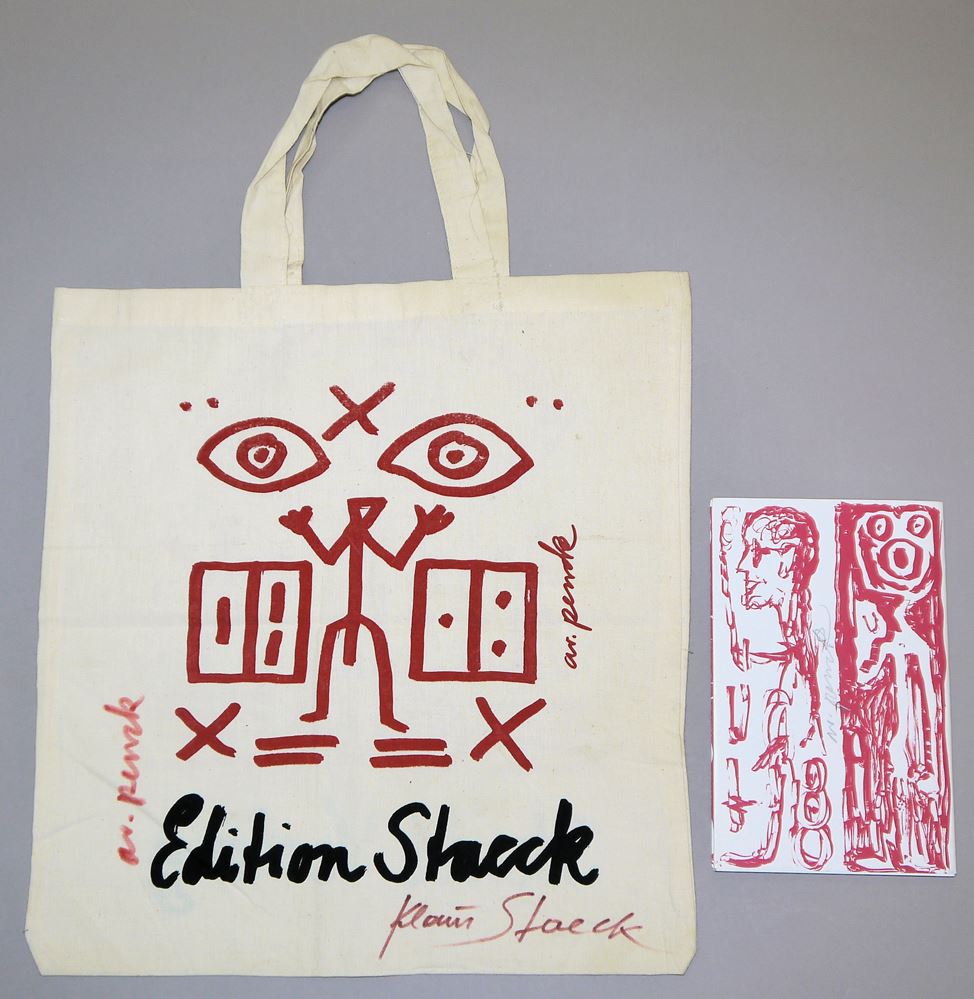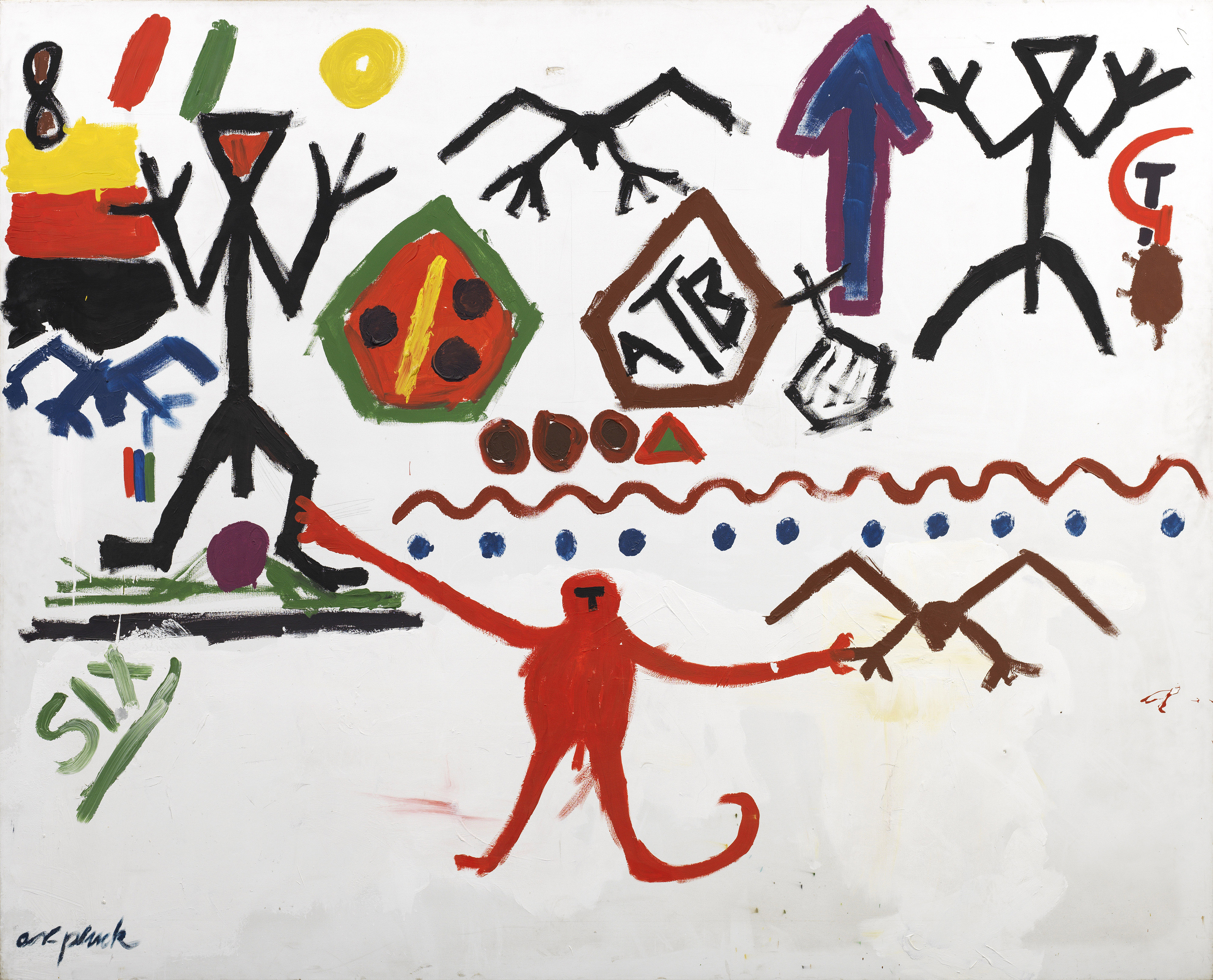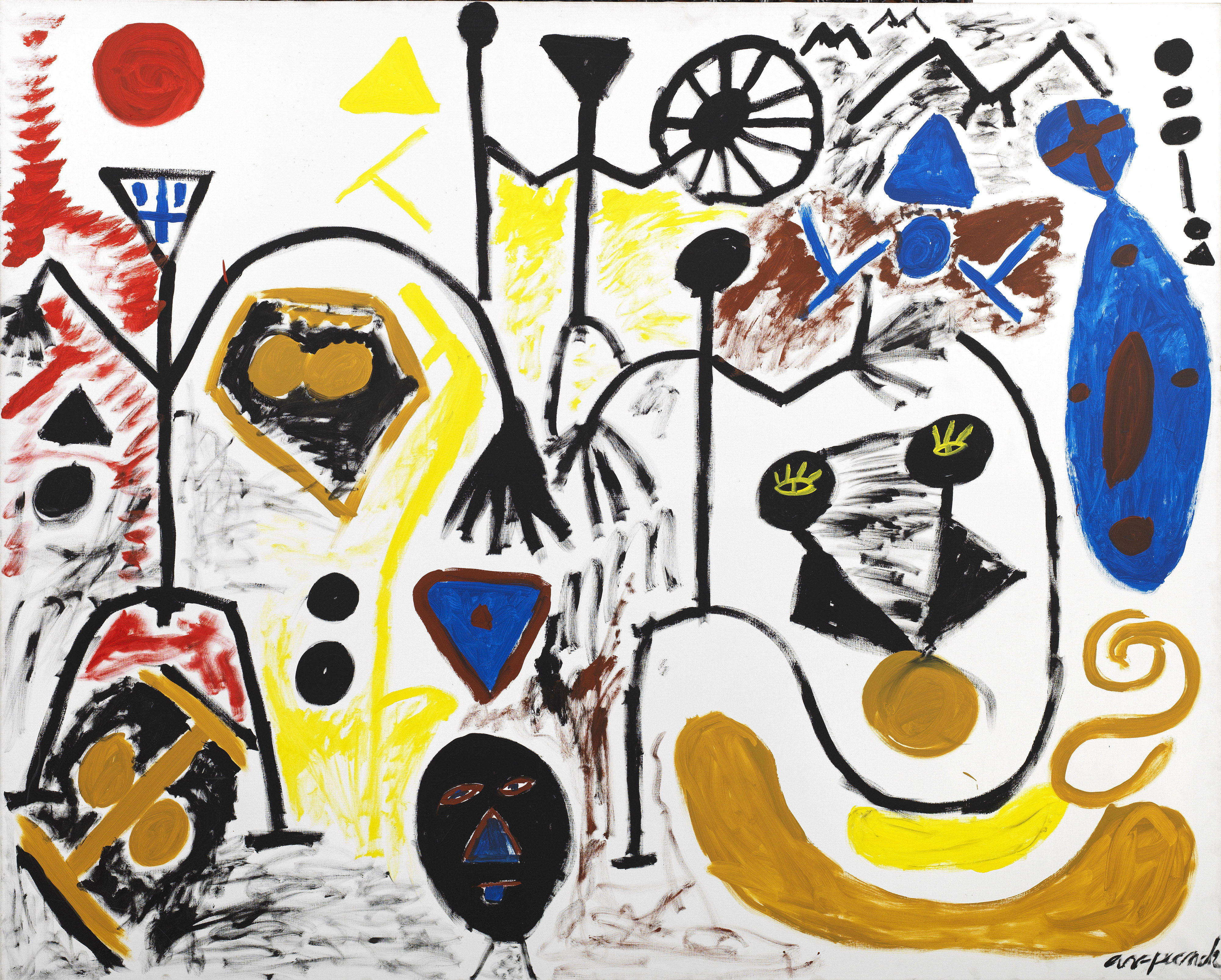A.R. Penck Follow Ali Alpha Tor titled 'ali alpha tor' lower left dispersion paint on canvas 294.6 x 294.6 cm (115 7/8 x 115 7/8 in.) Executed in 1975.
Provenance Galerie Michael Werner, Cologne The Collection of Georg Baselitz Derneburg Private Collection, Florida Exhibited Nationalgalerie Berlin, Staatliche Museen Preußischer Kulturbesitz; Kunsthaus Zürich, A.R. Penck, 22 April – 14 August 1988, no. 67, p. 181 (illustrated) Catalogue Essay Intensely graphic with brusquely painted lines and calligraphic elements, Ali Alpha Tor projects the viewer into the familiar and provocative world of A.R. Penck. Marking the height of Penck’s lifelong confrontation with the Socialist Realist style of Soviet Germany, Ali Alpha Tor , from 1975, is a rare and poignant composition by the celebrated artist. In the present work, the primal colouration and seemingly primitive nature of distorted figures conjures a form that would soon become uniquely representative of Penck’s oeuvre, a testament to his fearless and unwavering refusal to conform. In Ali Alpha Tor , thick black brushstrokes cut savagely across the canvas. Contorting and twisting, the lines form jagged geometric shapes which convulse with energy. Distinct from the artist’s later works, which focus entirely upon hieroglyphic symbols and iconography, this work focuses upon the raw, almost primeval nature of human behaviour. By the 1970s, Penck’s art had become the sole expression for his frustration and dissidence, addressing themes of humanity, communication and the relationship to the animal or celestial realm. The peculiar, feverish quality is suggestive of an extract from a battle scene as amalgamated silhouettes and limbs mutate and bend into irregular shapes. Forms of creatures are relegated into simplified symbols as hues of earthy reds, oranges and yellows saturate the canvas and emphasise the visceral quality of the work. As his work flourished during the seventies and eighties, Penck began to move away from his distinctive, monochromatic colour palette and introduced new tones as a means of expression. Here, the artist’s use of unrefined natural colours and minimalistic silhouettes is evocative of the arcane Lascaux Palaeolithic cave paintings, organic engravings left by unknown ancestors. Having painted many models of mankind, drawing on Lascaux as well as more modern and urban symbols, the artist seeks to craft a new visual language, synthetically reproducing the foundations of a communication with new values and ciphers. Ali Alpha Tor superbly highlights Penck’s inimitable ability to revolutionise the outwardly prehistoric in order to expose a new, uncultivated potential. In his search for independence, Penck’s work becomes timeless; questioning preconceived styles and artistic epochs, the artist poetically forges a realm compelled by paradise. From the outset, Penck used painting as a means for confronting a turbulent past. Alongside Markus Lüpertz and Georg Baselitz Penck’s work came to be a form of political protest, one forged from decades of opposition and his decisive journey from East to West Germany. Moving across from the East after his contemporaries, Penck was a late émigré from the German Democratic Republic in 1980 and was thus, self-taught, and free from the traditional figurative standards imparted by the East German artistic academies. At the heart of his work lies the artist’s memory, with the lasting impression of his traumatic experiences underpinning his personal poetic and artistic vision. Like Baselitz, Penck remained committed to the notion that art should, ultimately, reflect society and contribute positively and independently to Socialism. The artist’s friendship with Baselitz thus became an important link to the West, one which continued throughout his life and impacted significantly on his creative vision. Although perhaps more politicised than Penck, the visceral and tempestuous imagery in Baselitz’s work poignantly exposes the unhealed wounds in the cultural consensus of post-war Germany. In his Frakturbilder ( Fracture Paintings ) Baselitz violently manipulates form, the distorted nature
A.R. Penck Follow Ali Alpha Tor titled 'ali alpha tor' lower left dispersion paint on canvas 294.6 x 294.6 cm (115 7/8 x 115 7/8 in.) Executed in 1975.
Provenance Galerie Michael Werner, Cologne The Collection of Georg Baselitz Derneburg Private Collection, Florida Exhibited Nationalgalerie Berlin, Staatliche Museen Preußischer Kulturbesitz; Kunsthaus Zürich, A.R. Penck, 22 April – 14 August 1988, no. 67, p. 181 (illustrated) Catalogue Essay Intensely graphic with brusquely painted lines and calligraphic elements, Ali Alpha Tor projects the viewer into the familiar and provocative world of A.R. Penck. Marking the height of Penck’s lifelong confrontation with the Socialist Realist style of Soviet Germany, Ali Alpha Tor , from 1975, is a rare and poignant composition by the celebrated artist. In the present work, the primal colouration and seemingly primitive nature of distorted figures conjures a form that would soon become uniquely representative of Penck’s oeuvre, a testament to his fearless and unwavering refusal to conform. In Ali Alpha Tor , thick black brushstrokes cut savagely across the canvas. Contorting and twisting, the lines form jagged geometric shapes which convulse with energy. Distinct from the artist’s later works, which focus entirely upon hieroglyphic symbols and iconography, this work focuses upon the raw, almost primeval nature of human behaviour. By the 1970s, Penck’s art had become the sole expression for his frustration and dissidence, addressing themes of humanity, communication and the relationship to the animal or celestial realm. The peculiar, feverish quality is suggestive of an extract from a battle scene as amalgamated silhouettes and limbs mutate and bend into irregular shapes. Forms of creatures are relegated into simplified symbols as hues of earthy reds, oranges and yellows saturate the canvas and emphasise the visceral quality of the work. As his work flourished during the seventies and eighties, Penck began to move away from his distinctive, monochromatic colour palette and introduced new tones as a means of expression. Here, the artist’s use of unrefined natural colours and minimalistic silhouettes is evocative of the arcane Lascaux Palaeolithic cave paintings, organic engravings left by unknown ancestors. Having painted many models of mankind, drawing on Lascaux as well as more modern and urban symbols, the artist seeks to craft a new visual language, synthetically reproducing the foundations of a communication with new values and ciphers. Ali Alpha Tor superbly highlights Penck’s inimitable ability to revolutionise the outwardly prehistoric in order to expose a new, uncultivated potential. In his search for independence, Penck’s work becomes timeless; questioning preconceived styles and artistic epochs, the artist poetically forges a realm compelled by paradise. From the outset, Penck used painting as a means for confronting a turbulent past. Alongside Markus Lüpertz and Georg Baselitz Penck’s work came to be a form of political protest, one forged from decades of opposition and his decisive journey from East to West Germany. Moving across from the East after his contemporaries, Penck was a late émigré from the German Democratic Republic in 1980 and was thus, self-taught, and free from the traditional figurative standards imparted by the East German artistic academies. At the heart of his work lies the artist’s memory, with the lasting impression of his traumatic experiences underpinning his personal poetic and artistic vision. Like Baselitz, Penck remained committed to the notion that art should, ultimately, reflect society and contribute positively and independently to Socialism. The artist’s friendship with Baselitz thus became an important link to the West, one which continued throughout his life and impacted significantly on his creative vision. Although perhaps more politicised than Penck, the visceral and tempestuous imagery in Baselitz’s work poignantly exposes the unhealed wounds in the cultural consensus of post-war Germany. In his Frakturbilder ( Fracture Paintings ) Baselitz violently manipulates form, the distorted nature
.jpg)














Testen Sie LotSearch und seine Premium-Features 7 Tage - ohne Kosten!
Lassen Sie sich automatisch über neue Objekte in kommenden Auktionen benachrichtigen.
Suchauftrag anlegen